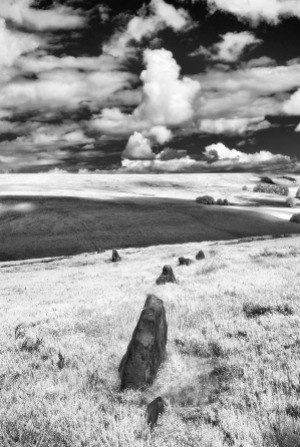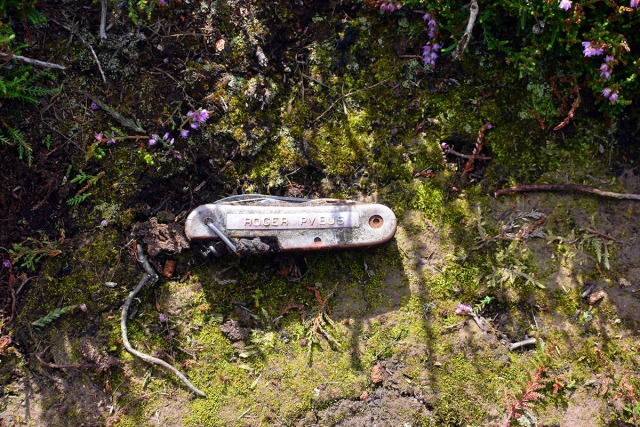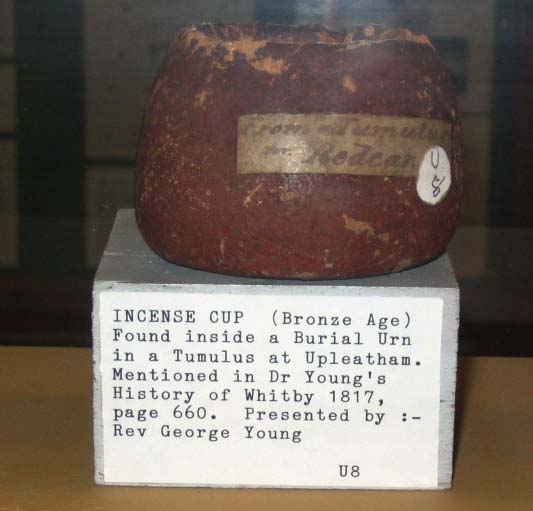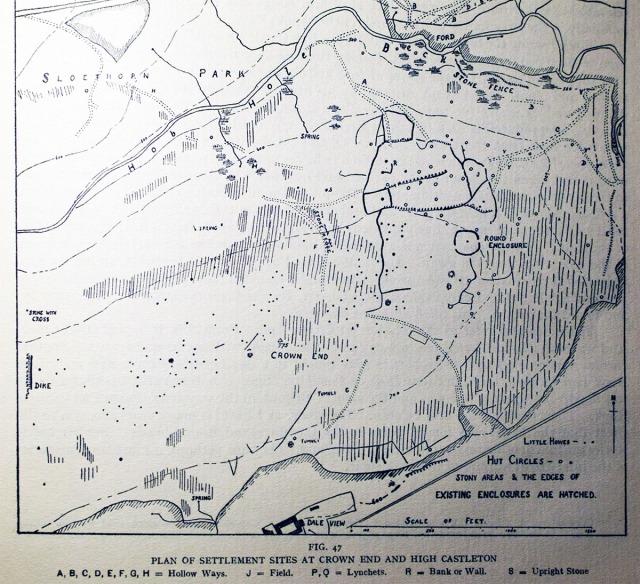This morning I headed over to Westerdale Moor. I’ve been visiting this moor for many years and have always had the place to myself. As I walked up to the moor from Hob Hole I noticed a group of estate workers over on Little Hograh Moor, I made a small bet with myself that I’d be getting a visit from a gamekeeper within half an hour of setting foot on the moor.
The heather is in full bloom and the moors look stunning, after a few short minutes my boots were covered in a fine dusting of heather pollen. Later I encountered thousands of tiny bees congregating on a sandy bank at the side of the path, I presume these were Miner bees making the most of the pollen harvest.
My first landmark on the moor was the standing stone which can be seen from the footpath on the west end of the moor, this stone is below the crest of the ridge and is about 1.2m tall
Due north of the stone and about 100m over the ridge of the moor is an alignment of standing stones and boulders that runs for about 70m towards the Baysdale Beck, also known as the Hob Hole Beck. This alignment has been interpreted as a Bronze Age boundary and features in Blaise Vyner’s inventory of Cross Ridge Boundaries.
Returning to the path I noticed an object embedded in the dry mud at the side of the track. It was a Swiss Army knife, it had obviously been there for a while and had a name dymo-taped onto it, Roger Pybus. I pocketed the knife and a minute or two later noticed a large 4×4 pickup heading across the moor towards me, less than half and hour, I had won my bet.
I walked up to the pickup and had a chat with the keeper. He was friendly enough and told me that he was checking to ensure that I wasn’t going to have a barbecue or fly a drone over the moor. He told me about the sculpture that his boss had erected on the far horizon. I told him that I was more interested in standing stones and asked him if Roger Pybus was one of the blokes he worked with, he said he was so I gave him the knife to return to its’ owner.
On the skyline, Seated Man, a sculpture by Sean Henry commissioned by the estate owner David Ross and erected on Castleton Rigg. To the right of the sculpture are a group of visitors.
The keeper, satisfied that I wasn’t a hungry drone pilot, went on his way and I continued eastward across the moor. This side of the moor is dotted with low cairns and banks.
My next destination was the large embanked enclosure on eastern end of the moor. The enclosure is located on fairly level ground just before it dips down into the valley to where the River Esk meets the Baysdale Beck.
The Enclosure is about 40m square with fairly well defined walls. The walls are made of stones with the occasional large upright stone on the inner face. The walls stand at about 1.5m high and 2-3m wide. There is a 3m entrance on the east side. The general consensus is that the structure is Iron Age in date, but this is not certain.
I spent a little time walking around the enclosure and admiring the views along the Esk Valley to Castleton and then headed back to the road and Hob Hole via the Esk Valley Walk footpath.
Regarding the relationship between Hob Hole and the prehistoric remains, Stanhope White makes this observation
..the belief in a race of little men who lived under the earth may stem from the first interaction of the Celts with the indigenous Bronze Age people. When from time to time, a howe was opened for some purpose, possibly to win stone, if the so-called incense cups were found, they were regarded as proof of the presence of little men.
The North York Moors. An Introduction. Stanhope White. 1979
Frank Elgee’s map of Crown End.
A lidar image and aerial view of the Crown End enclosure














Gamekeeper magnet?
looks like a grand day out – I was most tempted to have a quick wander onto Westerdale moor earlier in the year when i went looking for the Hob hole spring on the slope down to the beck. – but it was getting late so i resisted.
Folklore gives the impression that the Hobs were short hairy fella’s, yet Blakeborough has the story of the ‘Giants’ Lapstone at Hob Hole. The hob thrush/thurs name relates to the jotun so this might be an explanation.
Ah..I was trying to track down the reference to the great stone that used to be at Hob Hole
It is in Blakelbrough’s hand of glory book (i can scan the pages if you want it) the lapstone was used by cobblers to beat leather, and the giant (cobbler?) lived in a cave on stoney Ridge to the south of Hob Hole. He threw the stone and it landed next to the beck.
The story has some folklore about women sitting on the stone and throwing a shoe, and there are one or two other references to hobs and shoes.
not sure what the connection is, but the leprachaun in ireland is a shoemaker and there is the elves and the shoemaker story too.
Cheers G I’ve not read that. I was think of a reference to a large stone with a mark on it, devil’s hoof print or some such thing.
I’ve sent a pdf of the story to your hotmail its a 5mb attachment.
the hob hole stone had a foot shaped cavity in it – which apparently only a ‘virtuous woman’ could put her leg into. (sounds like a bit of victorian moralising?) but the other details about the site are fascinating. Sadly it was blown up in 1830.
The devils foot print rock was at Hood Hill near sutton bank. some interesting legends about that too – but sadly it was blown to bits in the 1950’s when a jet aircraft mysteriously crashed into the hill – the exact point of impact was the Devils stone.
its almost as if………
Hello, which museum is the ‘incense cup’ in?
Also do you know the map ref of the standing stone as I can’t see it in our site database.
Something on ‘incense cups’ came up yesterday here:
“On the surface, it didn’t seem very significant but, thankfully, Claire Copper, who had just finished a research project on these artefacts, immediately recognised it for what it was — a beautiful little ‘incense cup’. After much checking, we were delighted when it was confirmed the cup was what we thought it was. There are only four other examples of this particular type of ‘cup’ in the UK and they all hail from the Stonehenge area.”
(and yours in the photo it would appear?)
“These tiny artefacts are often highly decorated and mostly found in Early Bronze Age contexts — often associated with burials. Their use has been the subject of debate over the years. It has been suggested that they were used to carry embers to a funeral pyre, or perhaps for the burning of incense during burial ceremonies.”
Thanks for the ever interesting posts
Andy
Hi Andy
Incense cups are not uncommon in the archaeological record, the article may refer to a specific variation in this type of artifact. That particular example is in the Pannett Park Museum in Whitby. There are at least a dozen or so listed in the catalogue of the Mortimer collection plus other examples collected by Bateman, Anderson and other barrow diggers, a number of which ended up in the Mayer collection. These cups are also referred to as Accessory Cups.
The Grid Reference for the stone is NZ660069. It’s roughly on the same alignment as the boundary monument and may well be part of it.
cheers Gavin
Thanks, that’s interesting. And for the map ref which shows we do have a page for this stone and the dyke
http://www.megalithic.co.uk/article.php?sid=47550
Why would a gamekeeper be bothered about a drone?
I really don’t know.
Hi, I am currently sat on a campsite in Edale with a group of D of E assessors and we were just chatting about alternative venues for a Gold practice expedition. The North York Moors came up and one of our number recanted a tale of 30 years ago when, (as a lad) he had lost his pocket knife somewhere up there. You have probably guessed already, that young lad (now a grizzled mountain man) was/is Roger Pybus!
Just thought you might be interested to hear he has now seen the picture and was delighted to have a mystery explained!
Hi Richard,
30yrs blimey! Looks as though the keeper wasn’t being totally honest with me.